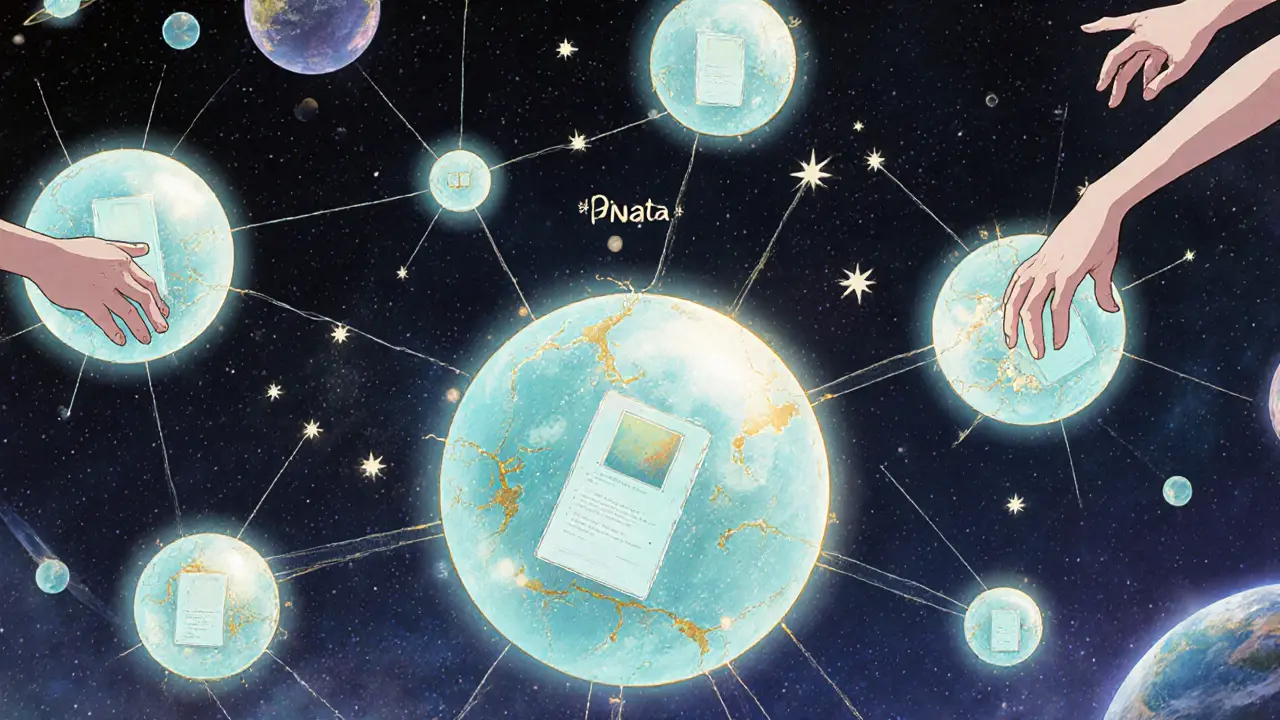IPFS vs Centralized NFT Storage: Which One Actually Protects Your Digital Assets?

Imagine buying an NFT of a digital artwork - paying thousands, feeling proud of owning something unique - only to open your wallet a year later and see a broken image. Just a blank space. A dead link. That’s not a glitch. That’s what happens when your NFT’s art is stored on a centralized server that shut down, got hacked, or got deleted by a CEO who changed his mind.
Most NFTs today don’t actually live on the blockchain. The blockchain only holds a tiny pointer - a URL - that says where the image, video, or audio file is stored. If that URL points to a company’s server, you’re trusting that company to stay alive, stay honest, and stay online forever. And that’s a dangerous bet.
Enter IPFS: the InterPlanetary File System. It’s not a company. It’s not a cloud service. It’s a protocol - a set of rules - that lets computers around the world share files directly with each other. No single boss. No central server. Just nodes, each holding pieces of the same data. If one goes down, another picks up the slack. That’s the core difference between IPFS and centralized storage. One promises permanence. The other just hopes for it.
How IPFS Actually Works (No Jargon)
On the regular web, you type in a URL like https://example.com/image.jpg. Your browser goes to that exact server, grabs the file, and shows it. If that server dies? The image dies with it.
IPFS flips that. Instead of asking for a file by its location, you ask for it by its fingerprint. Every file gets a unique hash - a long string of letters and numbers - like QmXoypizjW3WknFiJnKLwLcL76J3k28X512c1aZ8X7v8jY. That’s called a CID. That hash is the file’s identity. It doesn’t change. Not ever. Even if you rename the file, the hash stays the same. If someone tampers with the file? The hash changes. You’ll know right away.
When you upload to IPFS, your file gets split into chunks and spread across any node that agrees to store it. Someone in Tokyo, someone in Berlin, someone in Perth - they all keep copies. When you want to retrieve it, your device asks the network: "Who has this CID?" The closest node sends it back. No single company owns it. No one can take it down unless they shut down every node holding it - which is practically impossible.
Centralized Storage: The Easy Trap
Centralized storage sounds simple because it is. You drag your NFT image into OpenSea, Rarible, or a custom dashboard. Click upload. Done. The platform handles everything. They use Amazon S3, Google Cloud, or their own servers. It’s fast. It’s familiar. It’s what you’ve used for years.
But here’s the catch: you don’t own the server. You don’t control it. You don’t even know where it is.
Companies go bankrupt. Cloud providers change terms. Hackers breach systems. CEOs get tired of NFTs. In 2023, a major NFT marketplace shut down overnight. Thousands of NFTs lost their art. Collectors were left with tokens pointing to 404 errors. No one was liable. No one could fix it.
And here’s the worst part: many NFT projects claim they use "decentralized storage" because they store their metadata on IPFS - but they’re using Pinata, nft.storage, or Filebase to host it. Those are centralized companies. They run IPFS nodes. They control the pins. If Pinata goes under? Your NFT’s art disappears. You’re just using a decentralized protocol on top of a centralized crutch. It’s like saying your house is earthquake-proof because it’s built on concrete… but the concrete is owned by a landlord who can pull the foundation at any time.

Why IPFS Isn’t Perfect (And What You Need to Do About It)
IPFS sounds like the hero. But it’s not magic. It’s a tool. And tools need users to keep them alive.
Here’s the truth: IPFS doesn’t automatically store your files forever. Nodes only keep data if they’re told to - a process called "pinning." If no one pins your file, it eventually gets cleaned up. Think of it like leaving a book on a library shelf. If no one checks it out or reserves it, the librarian throws it out to make space.
That’s why most serious NFT projects don’t just upload to IPFS and walk away. They use pinning services. But if they use a centralized pinning service like Pinata, they’ve just recreated the same risk - just with a different name.
True decentralization means either:
- Running your own IPFS node and pinning your files yourself (requires technical skill and constant uptime)
- Using a truly distributed pinning network like Filecoin (where storage providers get paid in crypto to keep your data alive)
- Partnering with a community of collectors who pin your NFTs as a group
Without active pinning, your NFT’s art can vanish. Not because of a hack. Not because of a company shutdown. Just because no one remembered to keep it alive.
The Real Winner: On-Chain Storage (If You Can Afford It)
The most permanent solution? Store the art and metadata directly on the blockchain. No URLs. No servers. No pins. Just the data embedded in the token itself.
It’s called on-chain NFTs. And yes, it’s expensive. Storing a 5MB image on Ethereum costs hundreds of dollars in gas fees. That’s why most NFTs avoid it.
But some projects do it - like Art Blocks and CryptoPunks. Their art lives forever because the blockchain doesn’t go down. Not in 10 years. Not in 100. As long as Ethereum exists, so do their NFTs.
If you’re creating a high-value NFT collection - think digital collectibles, generative art, or cultural artifacts - on-chain is the only way to guarantee longevity. For everything else? You’re choosing between temporary convenience and long-term risk.

What Should You Do?
If you’re a collector:
- Check where your NFT’s metadata is stored. Look at the token’s contract on Etherscan. If it points to ipfs://, you’re on the right track - but then check if it’s pinned.
- Use tools like nft.storage or ipfs-checker.com to verify if the file is still accessible.
- Don’t assume your NFT is safe just because it’s on a big marketplace. OpenSea uses IPFS - but they don’t guarantee your file stays up.
If you’re a creator:
- Always use IPFS for metadata - never HTTP links.
- Don’t rely on Pinata or Filebase alone. Set up a backup pinning system using Filecoin or run your own node.
- For high-value collections, budget for on-chain storage. It’s not optional if you want your art to outlive your business.
- Consider Arweave - it’s a blockchain-based storage network that charges a one-time fee for permanent storage. No recurring bills. No pins needed.
There’s no perfect system. But there’s a clear hierarchy of risk:
- Centralized HTTP storage (highest risk)
- IPFS + centralized pinning (medium risk)
- IPFS + distributed pinning (lower risk)
- On-chain storage (lowest risk)
The NFT hype is built on ownership. But ownership means nothing if you can’t prove you still have the thing you bought. The blockchain guarantees the token. But only decentralized or on-chain storage guarantees the asset.
What’s Next?
The market is slowly waking up. More NFT projects are moving toward Filecoin, Arweave, and hybrid models. Tools are getting easier. Interfaces are improving. But the biggest barrier isn’t technology - it’s mindset.
People still think "decentralized" means "it’s on the blockchain." It doesn’t. It means "no single point of control." And that’s a hard habit to break.
If you want your NFTs to last - not just for a year, but for decades - stop trusting companies. Start trusting protocols. And if you can afford it? Put the art where it belongs: on the chain itself.
Because in the end, NFTs aren’t about JPEGs. They’re about proving you own something that can’t be taken away. And that only works if the thing you own doesn’t vanish when someone else turns off the lights.
Is IPFS truly decentralized if I use Pinata or nft.storage?
No. Pinata, nft.storage, and Filebase are centralized companies that run IPFS nodes on your behalf. While they use the IPFS protocol, they control the servers that pin your data. If they shut down, go bankrupt, or change policies, your NFT’s files can disappear. True decentralization requires either running your own node or using a distributed network like Filecoin where storage is paid for and maintained by multiple independent providers.
Can NFTs stored on IPFS disappear?
Yes - if no one is actively pinning the data. IPFS doesn’t store files automatically. Nodes only keep data they’re told to keep. Without pinning, files get cleaned up over time. Many NFTs have already vanished because their creators uploaded to IPFS but never ensured long-term pinning. Always verify your NFT’s CID is pinned by multiple sources or use a permanent storage solution like Arweave or Filecoin.
Why do big NFT marketplaces like OpenSea use IPFS?
OpenSea and similar platforms use IPFS because it reduces the risk of broken links compared to centralized servers. If a single server fails, IPFS can still serve the file from another node. But most of these platforms still rely on centralized pinning services (like Pinata) to keep data available. So while they’re better than pure HTTP storage, they’re not fully decentralized. They’re using IPFS as a more resilient middle ground - not as a true permanent solution.
Is on-chain NFT storage worth the cost?
For high-value, culturally significant, or long-term NFT collections - yes. On-chain storage means your NFT’s art lives as long as the blockchain does. There’s no dependency on servers, companies, or pinning services. Projects like CryptoPunks and Art Blocks use on-chain storage because they’re designed to last decades. For low-value or throwaway NFTs, the cost isn’t worth it. But if you’re building something meant to be owned forever, on-chain is the only real guarantee.
What’s the difference between IPFS and Arweave?
IPFS is a protocol for distributing files across a peer-to-peer network, but it doesn’t guarantee long-term storage. Arweave is a blockchain-based storage network that pays miners once to store data permanently. You pay a one-time fee, and your data is stored forever - no pinning, no recurring costs. Arweave solves IPFS’s biggest weakness: data permanence. If you want true permanence without running your own node, Arweave is currently the best option.
How do I check if my NFT’s file is still accessible?
Copy the CID from your NFT’s metadata (it starts with Qm…). Go to https://ipfs.io/ipfs/ and paste the CID after the slash (e.g., https://ipfs.io/ipfs/QmXoypizjW3WknFiJnKLwLcL76J3k28X512c1aZ8X7v8jY). If the image loads, it’s still available. You can also use tools like nftstorage.link or ipfs-checker.com to verify multiple gateways. If it doesn’t load, your NFT’s asset may be lost.
Sunita Garasiya
So we’re telling people to trust a protocol that doesn’t store anything unless someone remembers to pin it… like leaving your house keys under the mat and hoping the neighbor doesn’t forget to water the plants? IPFS is a beautiful idea wrapped in a lazy system. We need accountability, not just decentralization theater.
diljit singh
Bro just use Arweave. Done. Stop overthinking. You’re paying for NFTs not PhDs.